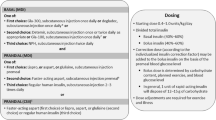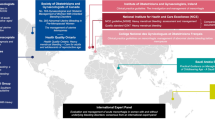Abstract
Purpose
This study assessed the accuracy of photometer based haemoglobin (Hb) determination technology (HemoCue®) when used by different anaesthetists in situations of rapidly changing Hb values during anaesthesia.
Methods
(Part 1) In the laboratory, repeated measurements were done on 16 split samples of blood using both the Hematology Analyzer (CELLDYN 3500 System™, Abbot Laboratories, San Jose, California) and the photometer. (Part 2) Twelve patients had blood samples drawn from an arterial line for simultaneous Hb determination in the hospital laboratory and by the photometer. At the same time, capillary samples were taken from the patient’s earlobe for Hb determination by the photometer. All sample collection and photometer measurements were done by the same operator. (Part 3) The Part 2 protocol was then repeated with different anaesthetists performing both the sampling and the photometer measurements. Statistical comparison was by ANOVA and a twotailed paired ttest.
Results
(Part 1) Samples determined by the photometer and the laboratory were highly correlated (r2 = 1.0, P < 0.001). The average error of each method was similar (< 4%). (Part 2) Using a 2-tailed paired ttest, the photometer arterial measurements were not different from the laboratory measurements, however the photometer capillary measurements were consistently ≈8% higher (P = 0.003). (Part 3) When multiple operators performed the sampling there were no differences on arterial or capillary samples (r2 = 0.942, r2 = 0.851 respectively), although the variance was greater.
Conclusions
The HemoCue® haemoglobinometer has sufficient accuracy to support treatment decisions regarding blood transfusions.
Résumé
Objectif
Évaluer la précision du titrage de l’hémoglobine (Hb) par la méthode photométrique (HémoCue®) lorsque différents anesthésistes l’utilisent pendant l’anesthésie dans des situations où la concentration de l’hémoglobine change rapidement.
Méthodes
(1e partie) En laboratoire, des mesures répétées ont été effectuées sur des échantillons de sang divisés en 16 fractions en utilisant à la fois l’Hemotology Analyzer (CELLDYN 3500 System, laboratoires Abbott, San Jose, Californie) et le photomètre. (2e partie) Des échantillons de sang provenant d’une canule artérielle ont été prélevés chez douze patients pour le titrage de l’hémoglobine par le laboratoire de l’hôpital et le photomètre. Le recueil de tous les échantillons et les mesures photométriques étaient réalisés par la même personne. (3e partie) Le protocole de la 2e partie a alors été répété par différents anesthésistes qui effectuaient à la fois les prélèvements et les mesures photométriques. La comparaison statistique a été établie par ANOVA et le test t pour groupes appariés.
Résultats
(1e partie) Les échantillons analysés par photométrie et laboratoire avaient un haut degré de corrélation (r2 = 1,0, P < 0,001). L’erreur moyenne de chaque méthode était identique (< 4%). (2e partie) Avec le test t apparié, les mesures du sang artériel par photométrie ne différaient pas des mesures du laboratoire; cependant, les mesures du sang capillaire par photométrie étaient invariablement plus élevées de 8% (P = 0,003). (3e partie) Quand plusieurs personnes effectuaient l’échantillonnage, il n’y a avait pas de différence entre les échantillons artériels ou capillaires (respectivement r2 = 0,92, r2 = 0,8510) bien que la variance ait été plus grande.
Conclusion
L’hémoglobinomètre HemoCue® est suffisamment précis pour justifier lu pertinence des transfusions sanguines.
Similar content being viewed by others
References
Neville RG. Evaluation of portable haemoglobinometer in general practice. Br Med J 1987; 294: 1263–5.
Chen PP, Short TG, Leung DHY, Oh TE. A clinical evaluation of the Hemocue haemoglobinometer using capillary, venous and arterial samples. Anaesth Intensive Care 1992; 20: 497–503.
Nicholls PD. An evaluation of the HemoCue™ for correcting the haemoglobin value of lipaemic samples. Medical Laboratory Sciences 1990; 47: 226–9.
Bland JM, Altman DG. Statistical methods for assessing agreement between two methods of clinical measurement. Lancet 1986; 1:307–10.
Miller RD. Transfusion therapy.In: Miller RD (Ed.). Anesthesia, 3rd ed. New York: Churchill Livingstone Inc., 1990: 1467–99.
Berne RM, Levy MN. Cardiovascular Physiology, 6th ed. St Louis: Mosby Year Book, 1992: 127–33.
Author information
Authors and Affiliations
Rights and permissions
About this article
Cite this article
Jaeger, M., Ashbury, T., Adams, M. et al. Perioperative on-site haemoglobin determination: as accurate as laboratory values?. Can J Anaesth 43, 795–798 (1996). https://doi.org/10.1007/BF03013031
Accepted:
Published:
Issue Date:
DOI: https://doi.org/10.1007/BF03013031




